Acer Aspire 7720, Aspire 7720G Service Manual

Asprire Poyang Series
Service Guide
Service guide files and updates are available on the ACER/CSD web; for more information, please refer to http://csd.acer.com.tw
PRINTED IN TAIWAN

Revision History
Please refer to the table below for the updates made on Aspire Poyang service guide.
Date |
Chapter |
Updates |
|
|
|
|
|
|
|
|
|
|
|
|
II

Copyright
Copyright © 2007 by Acer Incorporated. All rights reserved. No part of this publication may be reproduced, transmitted, transcribed, stored in a retrieval system, or translated into any language or computer language, in any form or by any means, electronic, mechanical, magnetic, optical, chemical, manual or otherwise, without the prior written permission of Acer Incorporated.
Disclaimer
The information in this guide is subject to change without notice.
Acer Incorporated makes no representations or warranties, either expressed or implied, with respect to the contents hereof and specifically disclaims any warranties of merchantability or fitness for any particular purpose. Any Acer Incorporated software described in this manual is sold or licensed "as is". Should the programs prove defective following their purchase, the buyer (and not Acer Incorporated, its distributor, or its dealer) assumes the entire cost of all necessary servicing, repair, and any incidental or consequential damages resulting from any defect in the software.
Acer is a registered trademark of Acer Corporation. Intel is a registered trademark of Intel Corporation.
Pentium and Pentium II/III are trademarks of Intel Corporation.
Other brand and product names are trademarks and/or registered trademarks of their respective holders.
III

Conventions
The following conventions are used in this manual:
SCREEN MESSAGES |
Denotes actual messages that appear |
|
on screen. |
|
|
NOTE |
Gives bits and pieces of additional |
|
information related to the current |
|
topic. |
|
|
WARNING |
Alerts you to any damage that might |
|
result from doing or not doing specific |
|
actions. |
|
|
CAUTION |
Gives precautionary measures to |
|
avoid possible hardware or software |
|
problems. |
|
|
IMPORTANT |
Reminds you to do specific actions |
|
relevant to the accomplishment of |
|
procedures. |
|
|
IV

Preface
Before using this information and the product it supports, please read the following general information.
1.This Service Guide provides you with all technical information relating to the BASIC CONFIGURATION decided for Acer's "global" product offering. To better fit local market requirements and enhance product competitiveness, your regional office MAY have decided to extend the functionality of a machine (e.g. add-on card, modem, or extra memory capability). These LOCALIZED FEATURES will NOT be covered in this generic service guide. In such cases, please contact your regional offices or the responsible personnel/channel to provide you with further technical details.
2.Please note WHEN ORDERING FRU PARTS, that you should check the most up-to-date information available on your regional web or channel. If, for whatever reason, a part number change is made, it will not be noted in the printed Service Guide. For ACER-AUTHORIZED SERVICE PROVIDERS, your Acer office may have a DIFFERENT part number code to those given in the FRU list of this printed Service Guide. You MUST use the list provided by your regional Acer office to order FRU parts for repair and service of customer machines.
V

VI

Chapter 1
System Specifications
Features
Below is a brief summary of the computer’s many features:
Operating system
Genuine Windows® VistaTM Capable
Genuine Windows® VistaTM Home Basic / Home Premium / Ultimate / Business Edition Genuine Windows® XP Home / Professional Edition (Service Pack 2)
Genuine Windows® XP Media Center / Tablet Edition Genuine Windows® 2000 (Service Pack 4)
NOTE: Windows® VistaTM Capable PCs come with Windows® XP installed, and can be upgraded to
Windows® VistaTM. For more information on Windows® VistaTM and how to upgrade, go to: Microsoft.com/windowsvista.
Platform and memory
Intel® Centrino® Merom mobile technology, featuring:
τIntel® CoreTM2 Duo processor T7300/T7500/T7700 (4MB, L2 cache 2.0/2.2/2.4, 800 MHz FSB) or higher
τIntel® CoreTM2 Duo processor T5450/T7100 (2MB, L2 cache 1.66/1.8, 667/800 MHz FSB) or higher
τIntel® 965PM/965GM Express chipset
Integrated Intel® PRO/Wireless 4965ABGN network connection (dual-band tri-mode 802.11a/b/g/ n) Wi-Fi CERTIFIEDTM solution, supporting Acer SignalUpTM wireless technology
Core logic: Intel® 965PM/965GM+ICH8M (north bridge+ south bridge)
Up to 2GB of DDR2 533/677 MHz memory, upgradeable to 4GB using two soDIMM modules (dual-channel support)
Display and graphics
17” WXGA+ high-brightness Acer CrystalBriteTM TFT LCD, 1680 x 1050 pixel resolution, 6 lamps 16 ms typical of/off and 8 ms average gray-to-gray response time
Simultaneous multi-window viewing via Acer VistaTM supported
Supporting NVIDIA® PureVideoTM technology (WMV HD, High-Definition MPEG-2 Hardware Acceleration, integrated HDTV encoder) dual-link DVI, Microsoft® DirectX® 9.0, Shader Model 3.0, OpenEXR High Dynamic Range (HDR) technology, NVIDIA® PowerMizerTM 6.0 and PCI Express® Dual independent display
16.2 million colors
MPEG-2/DVD hardware-assisted capability S-video/TV-out (NTSC/PAL) support
Acer ArcadeTM featuring Acer CinemaVisionTM and Acer ClearVision technologies
Audio
Intel® High Definition audio support
Two built-in Acer 3DSonic stereo speakers (1W)
Chapter 1 |
1 |

Dolby® Digital Live and DTS Neo: PC support
Sound Blaster ProTM and MS Sound compatible
Built-in microphone
Storage subsystem
Two 80/100/120/160/200 GB Serial ATA hard disk drives, supporting software RAID 0/1 Optical drive options: DVD-Super Multi double-layer drive (slot-load)
5-in-1 card reader, supporting Secure Digital (SD), MultiMediaCard (MMC), Memory Stick® (MS), Memory Stick PROTM (MS PRO), xD-Picture CardTM (xD)
Input devices
88/89-key Acer FineTouchTM keyboard with 5-degree curve Touchpad with 4-way scroll button
Four easy-launch buttons
Two front-access switches: WLAN LED and Bluetooth® LED-switches
Communication
Acer Video Conference, featuring Voice and Video over Internet Protocol (VVoIP) support via Acer OrbiCamTM and optional Acer Bluetooth® VoIP phone
Acer OrbiCamTM 0.3 megapixel CMOS camera, featuring:
τ30 degree ergonomic rotation
τAcer VisageOnTM technology
τAcer PrimaLiteTM technology
Modem: 56K ITU V.92 modem with PTT approval; wake-on ring ready LAN: gigabit Ethernet; wake-on-LAN ready
WPAN: Bluetooth® 2.0+EDR (Enhanced Data Rate)
WLAN: Intel® PRO/Wireless 4965ABGN network connection (dual-band tri-mode 802.11a/b/g/n) Wi-Fi® CERTIFIEDTM solution, supporting Acer SignalUpTM wireless technology
I/O Ports
PCI Express Card slot (54mm type)
5-in-1 card reader (SD/MMC/MS/MS PRO/xD) Four USB 2.0 ports
IEEE 1394 port
Microsoft MCE infrared (MIR) port External display (VGA) port DVI-D port (for selected models) S-video/TV-out (NTSC/PAL) port RF-in port (for selected models) AV-in port
Headphones port with S/PDIF support Microphone-in jack
Line-in jack
Ethernet (RJ-45) port Modem (RJ-11) port DC-in jack for AC adapter
2 |
Chapter 1 |

Environment
Temperature:
τOperating: 5ºC to 35ºC
τNon-operating: -20ºC to 65ºC Humidity (non-condensing):
τOperating: 20%~80%
τNon-operating: 20%~80%
Chapter 1 |
3 |
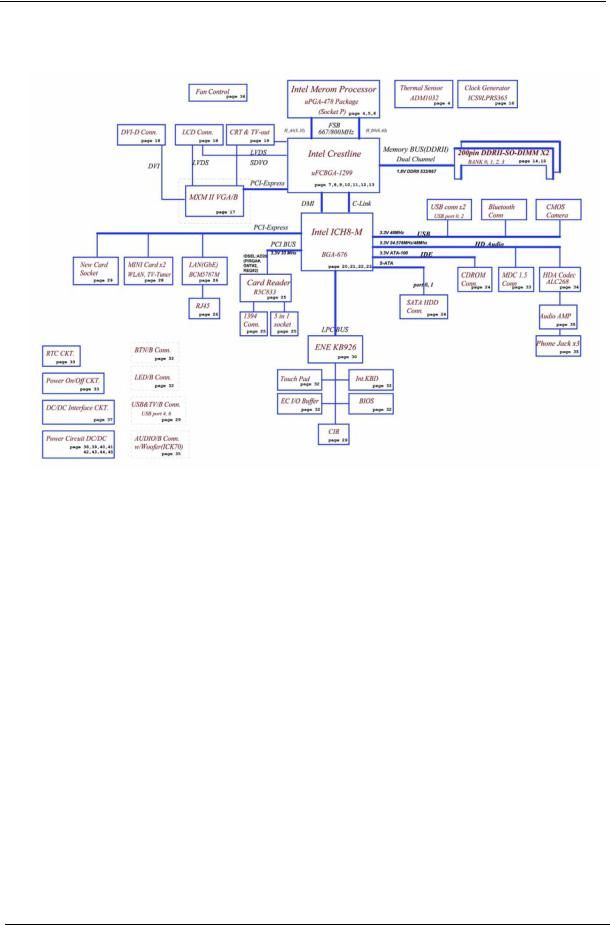
System Block Diagram
4 |
Chapter 1 |
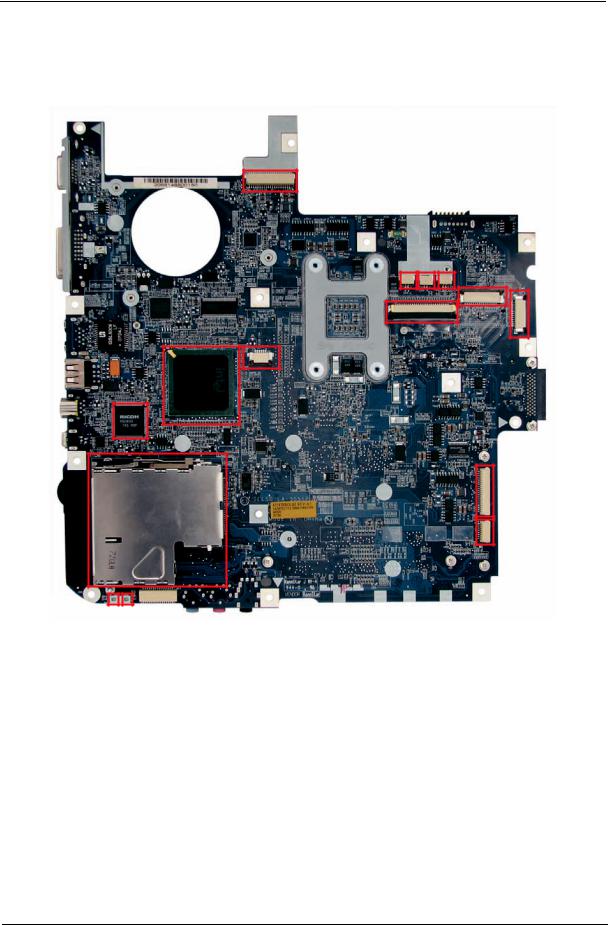
Board Layout
Top View
1
2 3 4
8 9
7
5 6
10
15
11
16
|
|
12 |
|
|
|
|
|
|
|
|
|
|
|
|
|
|
|
13 |
14 |
|
|
|
|
1 |
JP1 |
LCD Connector |
9 |
JP36 |
Mainboard to LED Board |
||
|
|
|
|
|
|
|
Connector |
2 |
JP3 |
Speaker (Left) Connector |
10 |
U12 |
|
||
3 |
JP34 |
Speaker (Right) Connector |
11 |
JP9 |
PCI Express Card Socket |
||
4 |
JP4 |
Internal MIC Connector |
12 |
LED1 |
Power/Suspend LED |
||
5 |
U5 |
South Bridge (ICH8M) |
13 |
LED2 |
Battery Charge/Discharge LED |
||
6 |
JP6 |
Internal Track-Pad Connector |
14 |
JP13 |
Mainboard to Audio Board |
||
|
|
|
|
|
|
|
Connector |
7 |
JP5 |
Internal Keyboard Connector |
15 |
JP11 |
Mainboard to USB Board |
||
|
|
|
|
|
|
|
Connector |
8 |
JP2 |
Mainboard to Button Board |
16 |
JP12 |
Bluetooth Module Connector |
||
|
|
Connector |
|
|
|
||
Chapter 1 |
5 |
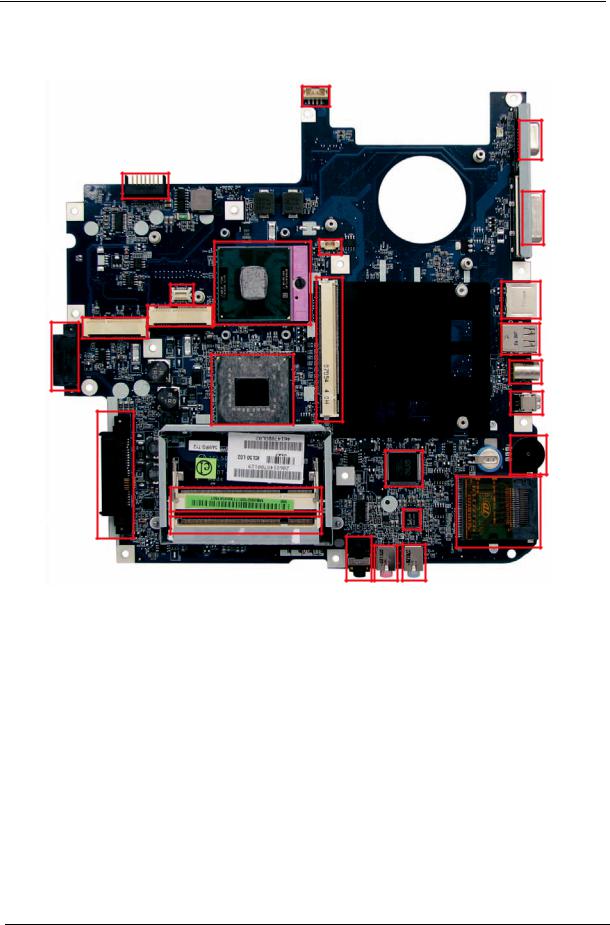
Bottom View
2
9
8
7
5 6
17
16
20
21
1
10
11
18
24
22 23 25
3
4
12
13
14
15
19
26
1 |
PJP1 |
DC-in Power Jack |
14 |
JP24 |
TV-out Connector |
2 |
PJP2 |
Battery Connector |
15 |
JP26 |
IEEE1394 Connector |
3 |
JP14 |
CRT Connector |
16 |
JP27 |
SATA HDD Connector |
4 |
JP15 |
DVI-D Connector |
17 |
U23 |
North Bridge (965PM/965GM) |
5 |
JP25 |
ODD Connector |
18 |
U28 |
|
6 |
JP20 |
Mini Card (WLAN) Socket |
19 |
U29 |
Volume Control |
7 |
JP19 |
Mini Card (TV-Tuner) Socket |
20 |
JP28 |
DDRII Memory Socket |
8 |
JP17 |
MDC Connector |
21 |
JP29 |
DDRII Memory Socket |
9 |
JP22 |
CPU Socket |
22 |
JP31 |
Headphone/SPDIF Jack |
10 |
JP16 |
Internal Fan Connector |
23 |
JP32 |
Mic-in Jack |
11 |
JP19 |
VGA Board Connector |
24 |
U33 |
Audio Codec Controller |
12 |
JP18 |
RJ45 (LAN) Connector |
25 |
JP33 |
Line-in Jack |
13 |
JP23 |
USB (Dual) Connectors |
|
|
|
6 |
Chapter 1 |
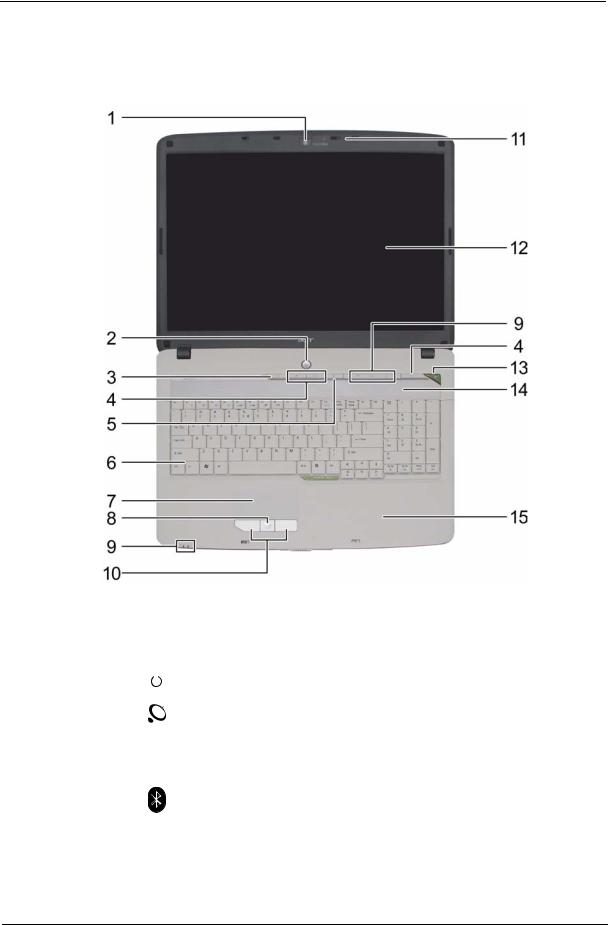
Your Acer Notebook Tour
After knowing your computer features, let us show you around your new Aspire computer.
Front View
# |
Icon |
Item |
Description |
|
|
|
|
|
|
1 |
|
|
Built-in camera |
0.3 megapixel web camera for video |
|
|
|
|
communication. |
|
|
|
|
|
2 |
|
|
Power button |
Turns the computer on and off. |
|
|
|||
|
|
|
|
|
3 |
|
|
Wireless communication |
Enables/disables the wireless function. |
|
|
|
button/indicator |
Indicates the status of wireless LAN |
|
|
|
|
communication. |
|
|
|
|
|
4 |
|
|
Easy-launch buttons |
Buttons for launching frequently used |
|
|
|
|
programs. |
|
|
|
|
|
5 |
|
|
Bluetooth® |
Enables/disables the Bluetooth® function. |
|
|
|
communication button/ |
Indicates the status of Bluetooth |
|
|
|
indicator |
communication. |
|
|
|
|
|
6 |
|
|
Keyboard |
For entering data into your computer. |
|
|
|
|
|
7 |
|
|
Touchpad |
Touch-sensitive pointing device which |
|
|
|
|
functions like a computer mouse. |
|
|
|
|
|
8 |
|
|
Scroll button |
Press up, down, left and right to scroll |
|
|
|
|
around the screen. |
|
|
|
|
|
Chapter 1 |
7 |
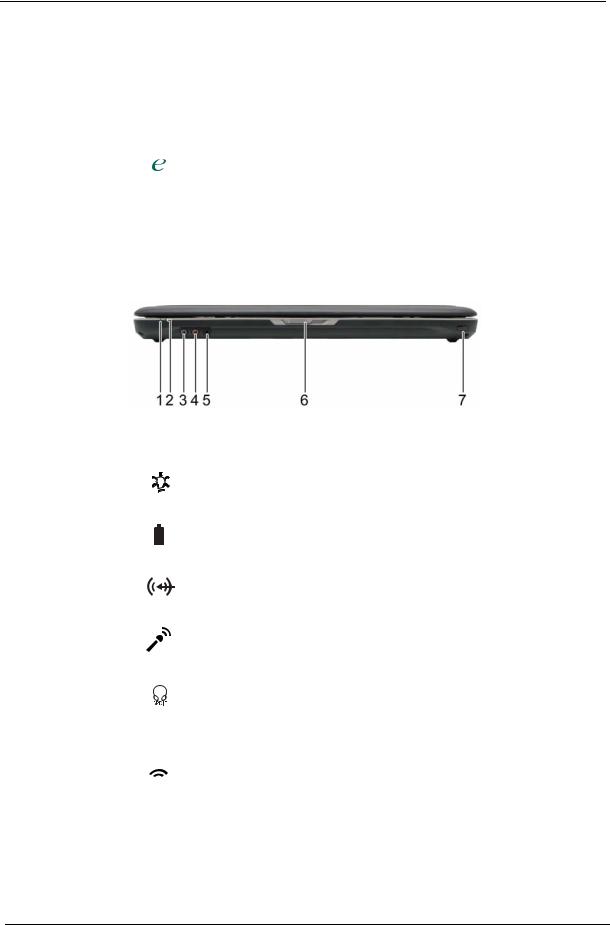
9 |
|
Status indicators |
Light-Emitting Diodes (LEDs) that light up |
|
|
|
to show the status of the computer’s |
|
|
|
functions and components. |
|
|
|
|
10 |
|
Click buttons (left and |
The left and right buttons function like the |
|
|
right) |
left and right mouse buttons. |
|
|
|
|
11 |
|
Microphone |
Internal microphone for sound recording. |
|
|
|
|
12 |
|
Display screen |
Also called Liquid-Crystal Display (LCD), |
|
|
|
displays computer output. |
|
|
|
|
13 |
|
Empowering button |
Launches the Empowering Technology |
|
|
|
toolbar. |
|
|
|
|
14 |
|
Speaker |
Left and right speakers deliver stereo audio |
|
|
|
output. |
|
|
|
|
15 |
|
Palmrest |
Comfortable support area for your hands |
|
|
|
when you use the computer. |
|
|
|
|
Closed Front View
# |
Icon |
Item |
Description |
||
|
|
|
|
|
|
1 |
|
|
|
Power indicator |
Indicates the computer’s power status. |
|
|
|
|
|
|
2 |
|
|
|
Battery indicator |
Indicates the computer’s battery status. |
|
|
|
|
|
|
|
|
|
|
|
|
|
|
|
|
|
|
3 |
|
|
|
Line-in jack |
Accepts audio line-in devices (e.g., audio |
|
|
|
|
|
CD player, stereo walkman). |
|
|
|
|
|
|
4 |
|
|
|
Microphone-in jack |
Accepts input from external microphones. |
|
|
|
|
|
|
5 |
|
|
|
Headphones/speaker/ |
Connects to audio line-out devices (e.g., |
|
|
|
|
line-out jack with S/PDIF |
speakers, headphones). |
|
|
|
|
support |
|
|
|
|
|
|
|
6 |
|
|
|
LCD display latch |
Secures the LCD display in place when |
|
|
|
|
|
closed. |
|
|
|
|
|
|
7 |
|
|
|
Infrared port |
Interfaces with infrared devices (e.g. |
|
|
|
|
|
infrared printer and IR-aware computer). |
|
|
|
|
|
|
|
|
|
|
|
|
|
|
|
|
|
|
8 |
Chapter 1 |
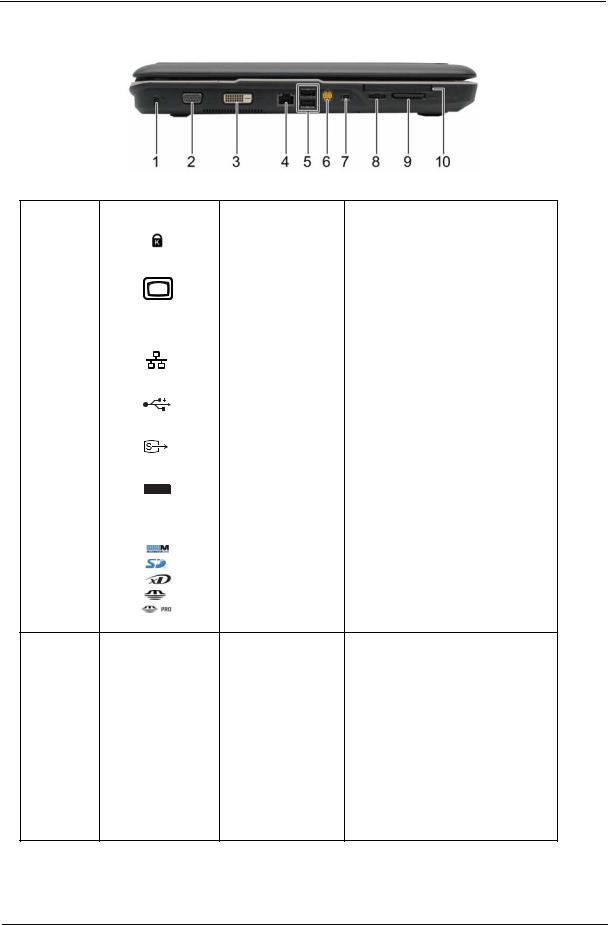
Left View
# |
Icon |
Item |
Description |
|
|
|
|
1 |
|
Kensington lock slot |
Connects to a Kensington-compatible |
|
|
|
computer security lock. |
|
|
|
|
2 |
|
External display (VGA) |
Connects to a display device (e.g., external |
|
|
port |
monitor, LCD projector). |
|
|
|
|
3 |
DVI |
DVI-D port |
Supports digital video connections. |
|
|
|
|
4 |
|
Ethernet (RJ-45) |
Connects to an Ethernet 10/100/1000- |
|
|
|
based network (for selected models). |
|
|
|
|
5 |
|
2 USB 2.0 port |
Connect to USB 2.0 devices (e.g., USB |
|
|
|
mouse, USB camera). |
|
|
|
|
6 |
|
S-video/TV-out (NTSC/ |
Connects to a television or display device |
|
|
PAL) port |
with S-video input. |
|
|
|
|
7 |
|
4-pin IEEE 1394 port |
Connects to IEEE 1394 devices. |
|
|
|
|
8 |
|
Volume control |
Increases and decreases the volume. |
|
|
|
|
9 |
|
5-in-1 card reader |
Accepts Secure Digital (SD), |
|
|
|
MultiMediaCard (MMC), Memory Stick |
|
|
|
(MS), Memory Stick PRO (MS PRO), xD- |
|
|
|
Picture Card (xD). |
10 |
PCI Express Card slot |
Accepts an Express Card/54 module. |
|
|
Note: Express Cards are third generation |
|
|
of PC cards, hot-swapable and maller than |
|
|
previous PC Cards. Designed for both |
|
|
desktop and mobile use, Express Cards |
|
|
use either USB 2.0 or a single lane PCI |
|
|
Express technology that provides 500 |
|
|
Mbytes/sec total throughput. Formerly |
|
|
code named “NEWCARD,” Express Cards |
|
|
are 5mm thick like Type II PC Cards, but do |
|
|
not use the same 86x54mm footprint. |
|
|
Express Cards come in 75x54mm and |
|
|
75x34mm sizes. Express Card/54 slot |
|
|
means this notebook accepts 75x54mm |
|
|
Express Cards. |
Chapter 1 |
9 |
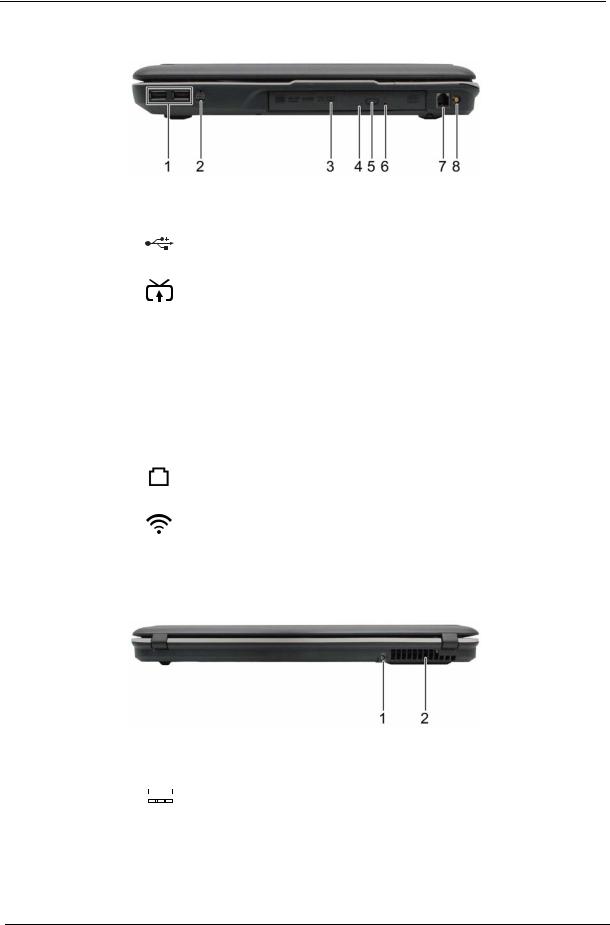
Right View
# |
Icon |
Item |
Description |
|
|
|
|
1 |
|
2 USB 2.0 ports |
Connect to USB 2.0 devices (e.g., USB |
|
|
|
mouse, USB camera). |
|
|
|
|
2 |
|
AV-in port |
Accepts input signals from audio/video |
|
|
|
(AV) devices. |
|
|
|
|
3 |
|
Optical drive |
Internal optical drive; accepts CDs or DVDs |
|
|
|
(slot-load or tray-load depending on |
|
|
|
model). |
|
|
|
|
4 |
|
Optical disk access |
Lights up when the optical drive is active. |
|
|
indicator |
|
|
|
|
|
5 |
|
Optical drive eject |
Ejects the optical disk from the drive. |
|
|
button |
|
|
|
|
|
6 |
|
Emergency eject hole |
Ejects the optical drive tray when the |
|
|
|
computer is turned off. |
|
|
|
|
7 |
|
Modem (RJ-11) port |
Connects to a phone line. |
|
|
|
|
8 |
|
RF-in port |
Accepts input signals from analog/digital |
|
|
|
TV-tuner devices (for selected models). |
|
|
|
|
Rear view
# |
|
Icon |
Item |
Description |
|||||
|
|
|
|
|
|
|
|
|
|
1 |
|
|
|
|
|
|
|
DC-in jack |
Connects to an AC adapter. |
|
|
|
|
|
|
|
|
|
|
|
|
|
|
|
|
|
|
|
|
2 |
|
|
|
|
|
|
|
Ventilation slots |
Enable the computer to stay cool, even |
|
|
|
|
|
|
|
|
|
after prolonged use. |
|
|
|
|
|
|
|
|
|
|
10 |
Chapter 1 |
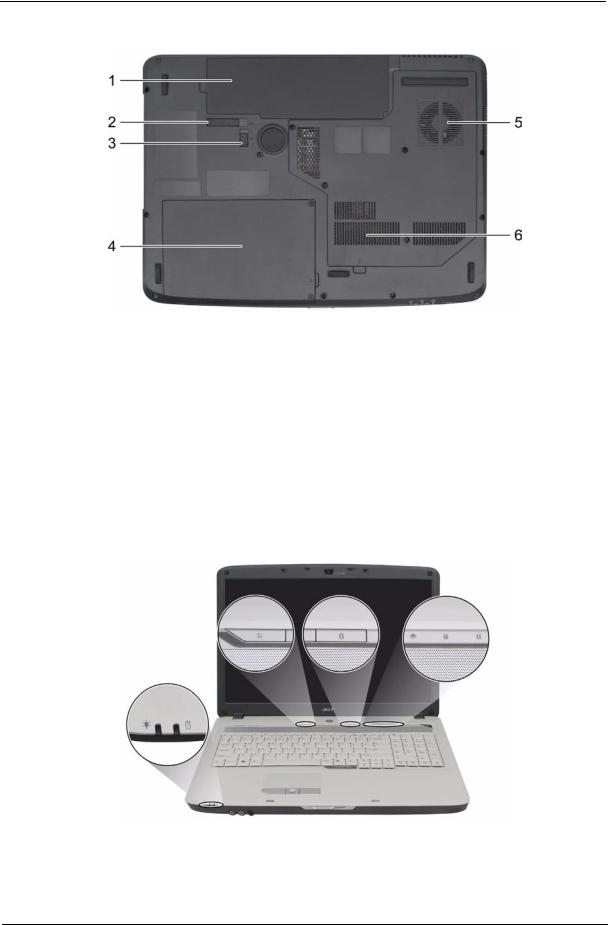
Base view
# |
Item |
Description |
|
|
|
1 |
Battery bay |
Houses the computer’s battery pack. |
|
|
|
2 |
Battery release latch |
Releases the battery for removal. |
|
|
|
3 |
Battery lock |
Locks the battery in position. |
|
|
|
4 |
Hard disk bay |
Houses the computer’s hard disk (secured with screws) |
|
|
|
5 & 6 |
Ventilation slots and |
Enable the computer to stay cool, even after prolonged use. |
|
cooling fan |
Note: Do not cover or obstruct the opening of the fan. |
|
|
|
Indicators
The computer has several easy-to-read status indicators.
The front panel indicators are visible even when the computer cover is closed up.
Chapter 1 |
11 |
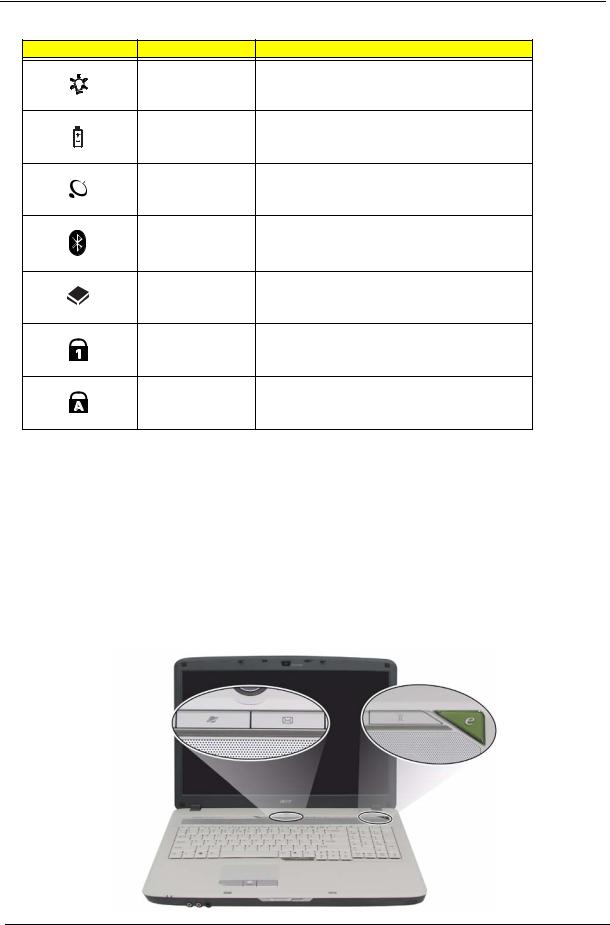
Icon |
Function |
Description |
|
Power |
Lights up when the computer is on. |
|
Battery |
Lights up when the battery is being charged. |
|
Wireless LAN |
Indicates the status of wireless LAN communication. |
|
Bluetooth |
Indicates the status of Bluetooth communication. |
|
HDD |
Indicates when the hard disc or optical drive is active. |
|
Num lock |
Lights when Num Lock is activated. |
|
Cap lock |
Lights when Cap Lock is activated |
NOTE: 1. Charging: The light shows amber when the battery is charging. 2. Fully charged: The light shows green when in AC mode.
Easy-Launch Buttons
To the top of the keyboard there are four easy-launch buttons: Web browser, mail, arcade buttons and an Empowering Key “  .
.
Press “  “ to run the Acer Empowering Technology. The mail and Web browser buttons are pre-set to email and Internet programs, but can be reset by users. To set the Web browser and mail buttons, run the Launch Manager.
“ to run the Acer Empowering Technology. The mail and Web browser buttons are pre-set to email and Internet programs, but can be reset by users. To set the Web browser and mail buttons, run the Launch Manager.
12 |
Chapter 1 |
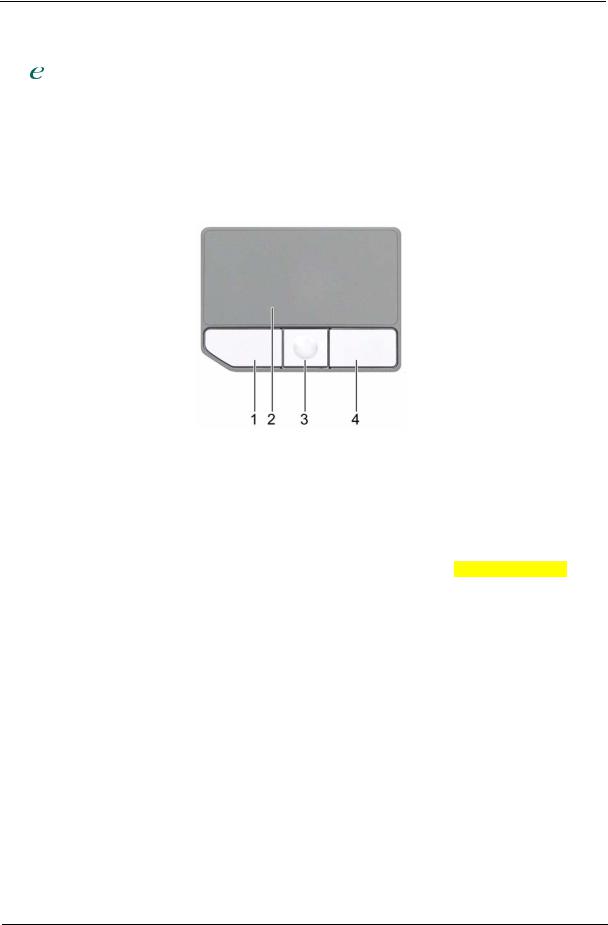
Launch Button |
Default application |
|
|
|
Acer Empowering Technology (user-programmable) |
|
|
Web browser |
Internet browser (user-programmable) |
|
|
Email application (user-programmable) |
|
|
|
Arcade |
Windows Media Center |
|
|
Touchpad Basics
The following teaches you how to use the touchpad:
Move your finger across the touchpad (2) to move the cursor.
Press the left (1) and right (4) buttons located beneath the touchpad to perform selection and execution functions. These two buttons are similar to the left and right buttons on a mouse. Tapping on the touchpad is the same as clicking the left button.
The center (3) button to mimics your cursor pressing on the right scroll bar of Windows applications.
Function |
Left Button (1) |
Right Button (4) |
Main touchpad (2) |
Center button (3) |
|
|
|
|
|
Execute |
Click twice quickly |
|
Tap twice (at the |
|
|
|
|
same speed as |
|
|
|
|
double-clicking the |
|
|
|
|
mouse button) |
|
|
|
|
|
|
Select |
Click once |
|
Tap once |
|
|
|
|
|
|
Drag |
Click and hold, then |
|
Tap twice (at the |
|
|
use finger on the |
|
same speed as |
|
|
touchpad to drag |
|
double-clicking a |
|
|
the cursor. |
|
mouse button); rest |
|
|
|
|
your finger on the |
|
|
|
|
touchpad on the |
|
|
|
|
second tap and |
|
|
|
|
drag the cursor. |
|
|
|
|
|
|
Access context |
|
Click once |
|
|
menu |
|
|
|
|
|
|
|
|
|
Scroll |
|
|
|
Click and hold to |
|
|
|
|
move up/down/left/ |
|
|
|
|
right. |
|
|
|
|
|
NOTE: When using the touchpad, keep it - and your fingers - dry and clean. The touchpad is sensitive to finger movements; hence, the lighter the touch, the better the response. Tapping too hard will not increase the touchpad’s responsiveness.
Chapter 1 |
13 |

Using the Keyboard
The keyboard has full-sized keys and an embedded keypad, separate cursor keys, one Windows key and twelve function keys.
Lock Keys and embedded numeric keypad
The keyboard has three lock keys which you can toggle on and off.
Lock Key |
Description |
|
|
Caps Lock |
When Caps Lock is on, all alphabetic characters typed |
|
are in uppercase. |
|
|
Num lock |
When Num Lock is on, the embedded keypad is in |
<Fn>+<F11> |
numeric mode. The keys function as a calculator |
|
(complete with the arithmetic operators +, -, *, and /). |
|
Use this mode when you need to do a lot of numeric |
|
data entry. A better solution would be to connect an |
|
external keypad. |
|
|
Scroll lock |
When Scroll Lock is on, the screen moves one line up |
<Fn>+<F12> |
or down when you press the up or down arrow keys |
|
respectively. Scroll Lock does not work with some |
|
applications. |
|
|
The embedded numeric keypad functions like a desktop numeric keypad. It is indicated by small characters located on the upper right corner of the keycaps. To simplify the keyboard legend, cursor-control key symbols are not printed on the keys.
Desired Access |
Num Lock On |
Num Lock Off |
|
|
|
Number keys on embedded |
Type numbers in a normal |
|
keypad |
manner. |
|
|
|
|
Cursor-control keys on |
Hold <Shift> while using |
Hold <Fn> while using |
embedded keypad |
cursor-control keys. |
cursor-control keys. |
|
|
|
Main keyboard keys |
Hold <Fn> while typing |
Type the letters in a normal |
|
letters on embedded |
manner. |
|
keypad. |
|
|
|
|
14 |
Chapter 1 |
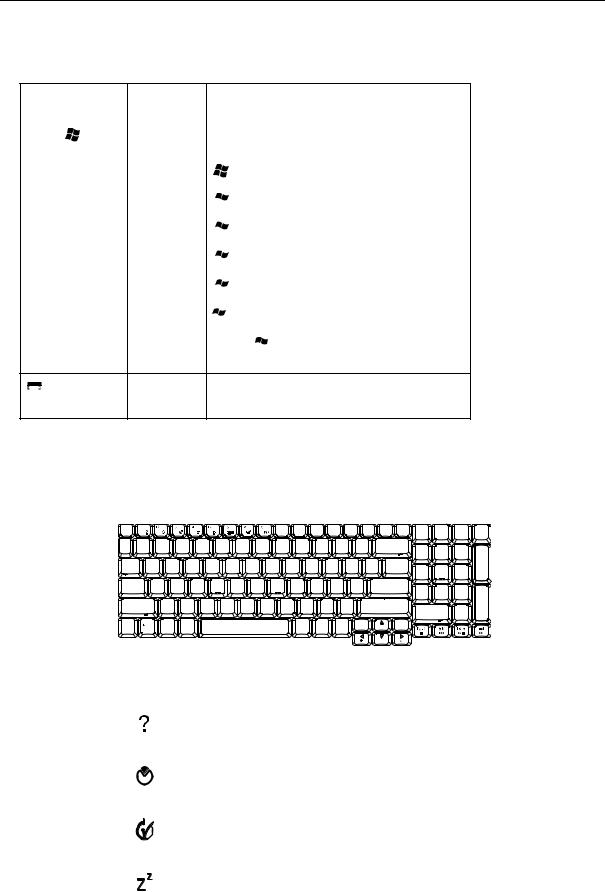
Windows Keys
The keyboard has one key that performs Windows-specific functions.
Key |
Icon |
Description |
|
|
|
Windows key |
|
Pressed alone, this key has the same effect as |
|
|
clicking on the Windows Start button; it launches the |
|
|
Start menu. It can also be used with other keys to |
|
|
provide a variety of function: |
+ <Tab> Activates next taskbar button.
 + <E> Opens the My Computer window
+ <E> Opens the My Computer window
 + <F1> Opens Help and Support.
+ <F1> Opens Help and Support.
 + <F> Opens the Search: All Files dialog box.
+ <F> Opens the Search: All Files dialog box.
 + <R> Opens the Run dialog box.
+ <R> Opens the Run dialog box.
 + <M> Minimizes all windows.
+ <M> Minimizes all windows.
<Shift>+  + <M> Undoes the minimize all windows action.
+ <M> Undoes the minimize all windows action.
This key has the same effect as clicking the right


 Application key mouse button; it opens the application’s context menu.
Application key mouse button; it opens the application’s context menu.
Hot Keys
The computer employs hotkeys or key combinations to access most of the computer’s controls like screen brightness, volume output, and the BIOS utility.
To activate hot keys, press and hold the <Fn> key before pressing the other key in the hotkey combination.
|
Hot Key |
Icon |
Function |
Description |
|
|
|
|
|
|
|
|
<Fn>+<F1> |
|
Hot key help |
Displays help on hot keys. |
|
|
|
|
|
|
|
|
<Fn>+<F2> |
|
Acer eSettings |
Launches the Acer eSettings in Acer eManager. |
|
|
|
|
|
|
|
|
<Fn>+<F3> |
|
Acer ePower |
Launches the Acer ePower Management in Acer |
|
|
|
|
Management |
Empowering Technology. See “Acer Empowering |
|
|
|
|
|
Technology” on page 18. |
|
|
|
|
|
|
|
|
<Fn>+<F4> |
|
Sleep |
Puts the computer in Sleep mode. |
|
|
|
|
|
|
|
|
|
|
|
|
|
Chapter 1 |
15 |
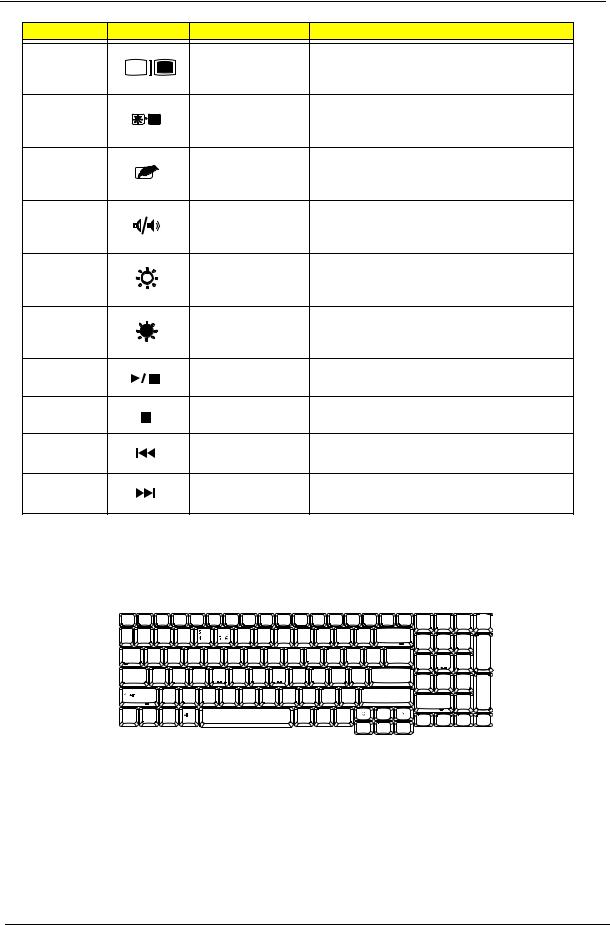
Hot Key |
Icon |
Function |
Description |
<Fn>+<F5> |
|
Display toggle |
Switches display output between the display screen, |
|
|
|
external monitor (if connected) and both. |
<Fn>+<F6> |
|
Screen blank |
Turns the display screen backlight off to save power. |
|
|
|
Press any key to return. |
<Fn>+<F7> |
|
Touchpad toggle |
Turns the internal touchpad on and off. |
<Fn>+<F8> |
|
Speaker toggle |
Turns the speakers on and off. |
<Fn>+<x> |
|
Brightness up |
Increases the screen brightness. |
<Fn>+<z> |
|
Brightness down |
Decreases the screen brightness |
<Fn>+<Home> |
|
Play/Pause |
Plays or pauses the media. |
<Fn>+<Pg Up> |
|
Stop |
Stops the media playing. |
<Fn>+<Pg Dn> |
|
Previous |
Returns to previous media file. |
<Fn>+<End> |
|
Next |
Jumps to next media file. |
Special Key
You can locate the Euro symbol and US dollar sign at the upper-center and/or bottom-right of your keyboard. To type:
The Euro symbol
1.Open a text editor or word processor.
2.Either directly press the <  > symbol at the bottom-right of the keyboard, or hold <Alt Gr> and then press the<5> symbol at the upper-center of the keyboard.
> symbol at the bottom-right of the keyboard, or hold <Alt Gr> and then press the<5> symbol at the upper-center of the keyboard.
NOTE: Some fonts and software do not support the Euro symbol. Please refer to www.microsoft.com/ typography/faq/faq12.htm for more information.
16 |
Chapter 1 |

The US dollar sign
1.Open a text editor or word processor.
2.Either directly press the < > key at the bottom-right of the keyboard, or hold <Shift> and then press the <4> key at the upper-center of the keyboard.
> key at the bottom-right of the keyboard, or hold <Shift> and then press the <4> key at the upper-center of the keyboard.
NOTE: This function varies by the operating system version.
Chapter 1 |
17 |

Acer Empowering Technology
Acer’s innovative Empowering Technology makes it easy for you to access frequently used functions and manage your new Acer notebook. It features the following handy utilities:
Acer eNet Management hooks up to location-based networks intelligently. Acer ePower Management extends battery power via versatile usage profiles.
Acer ePresentation Management connects to a projector and adjusts display settings conveniently. Acer eDataSecurity Management protects data with passwords and advanced encryption algorithms. Acer eLock Management limits access to external storage media.
Acer eRecovery Management backs up and recovers data flexibly, reliably and completely. Acer eSettings Management accesses system information and adjusts settings easily.
Acer ePerformance Management improves system performance by optimizing disk space, memory and registry settings.
For more information, press the <  > key to launch the Empowering Technology toolbar, then click on the appropriate utility and select the Help or Tutorial function.
> key to launch the Empowering Technology toolbar, then click on the appropriate utility and select the Help or Tutorial function.
Empowering Technology password
Before using Acer eLock Management and Acer eRecovery Management, you must initialize the Empowering Technology password. Right-click on the Empowering Technology toolbar and select “Password Setup” to do so. If you do not initialize the Empowering Technology password, you will be prompted to do so when running Acer eLock Management or Acer eRecovery Management for the first time.
Acer eNet Management 
Acer eNet Management helps you to quickly and easily connect to both wired and wireless networks in a variety of locations. To access this utility, either click on the “Acer eNet Management” icon on your notebook, or start the program from the Start menu. You also have the option to set Acer eNet Management to start automatically when you boot up your PC.
Acer eNet Management automatically detects the best settings for a new location, while offering you the freedom to manually adjust the settings to match your needs.
18 |
Chapter 1 |
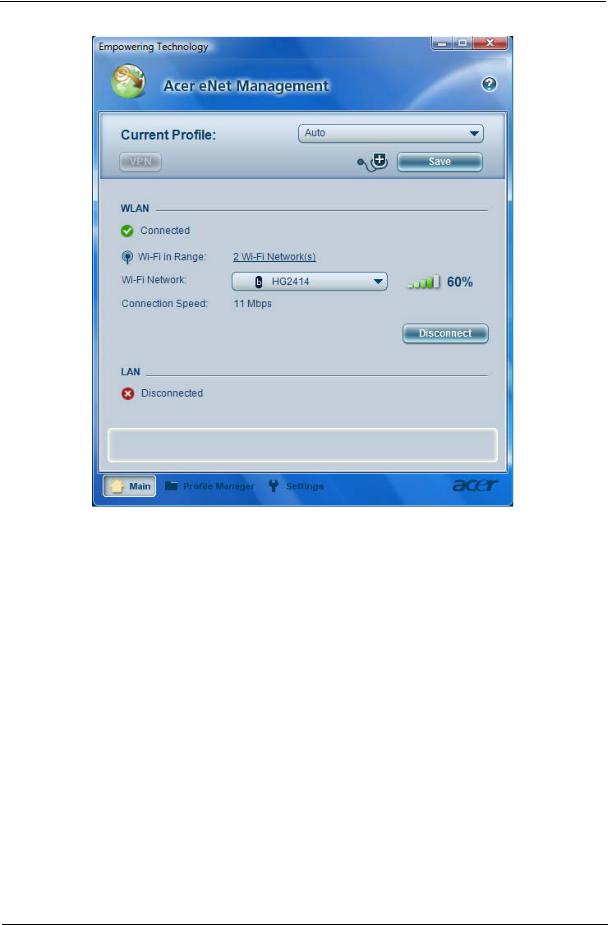
Acer eNet Management can save network settings for a location to a profile, and automatically switch to the appropriate profile when you move from one location to another. Settings stored include network connection settings (IP and DNS settings, wireless AP details, etc.), as well as default printer settings.
Security and safety concerns mean that Acer eNet Management does not store username and password information.
Chapter 1 |
19 |
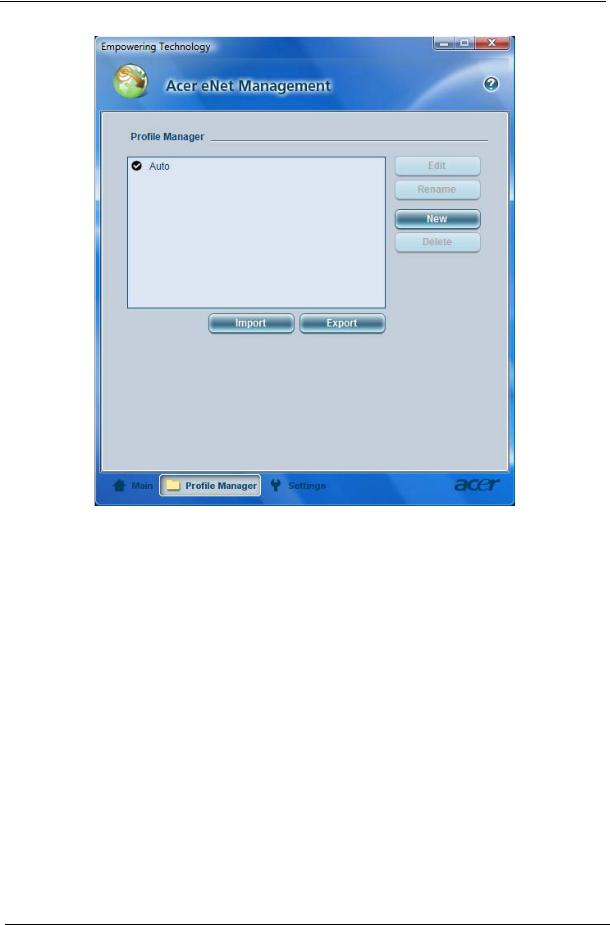
Acer ePower Management 
Acer ePower Management features a straightforward user interface. To launch it, select Acer ePower Management from the Empowering Technology interface.
AC Mode (Adapter mode)
The default setting is “Maximum Performance.” You can adjust CPU speed, LCD brightness and other settings, or click on buttons to turn the following functions on/off: Wireless LAN, Bluetooth, CardBus, FireWire (1394), Wired LAN and Optical Device if supported.
DC Mode (Battery mode)
There are three pre-defined profiles - Balanced, Power Saver, and High Performance. You can also define the power plan optimized for your needs.
To create new power plan
1.Select a predefined power plan and click the “ “ icon shown on the lower left-hand side.
“ icon shown on the lower left-hand side.
2.Enter the name for the newly created power plan.
3.Select one of the predefined power plan that is closest to what you want.
4.Change the display and sleep settings as desired.
5.Click “OK“ to apply the setting.
6.A new power plan is created.
20 |
Chapter 1 |
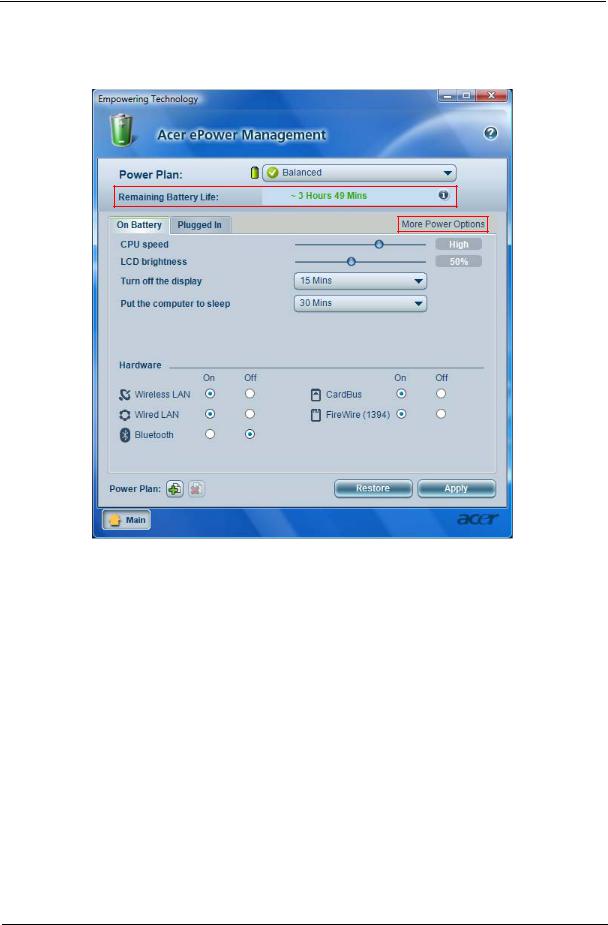
Battery status
For real-time battery life estimates based on current usage, refer to the time shown in the “Remaining Battery Life” field.
For additional power options, click “More Power option”.
Acer ePresentation Management 
Acer ePresentation Management lets you project your computer’s display to an external device or project using the hot key: Fn + F5. If auto-detection hardware is implemented in the system, your system display will be automatically switched out when an external display is connected to the system.
Chapter 1 |
21 |
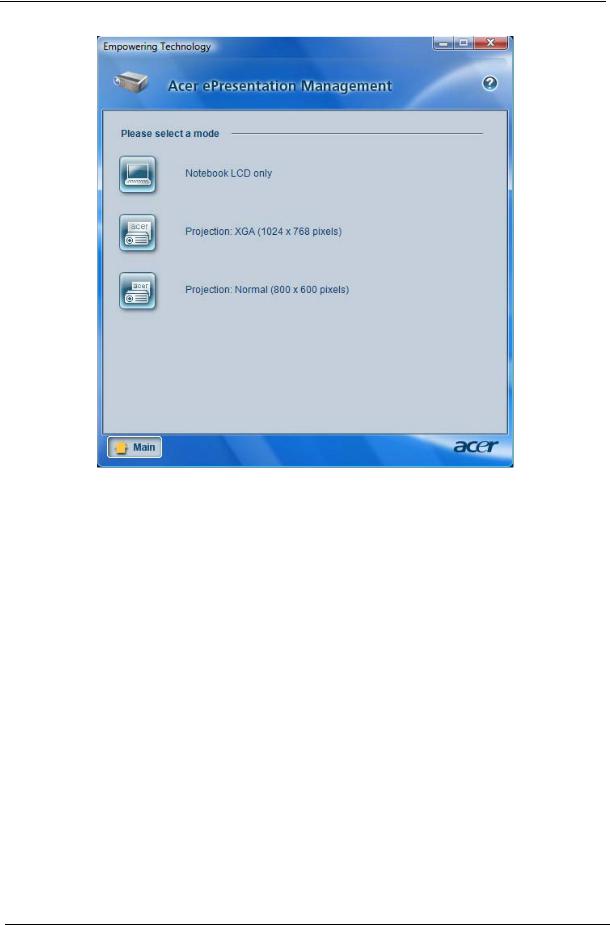
Acer eDataSecurity Management 
Acer eDataSecurity Management is handy file encryption utility that protects your files from being accessed by unauthorized persons. It is conveniently integrated with Windows explorer as a shell extension for quick and easy data encryption/decryption and also supports on-the-fly file encryption for MSN Messenger and Microsoft Outlook.
The Acer eDataSecurity Management setup wizard will prompt you for a supervisor password and default encryption. This encryption will be used to encrypt files by default, or you can choose to enter your won filespecific password when encrypting a file.
NOTE: The password used encrypt a file is the unique key that the system needs to decrypt it. If you lose the password, the supervisor password is the only other key capable of decrypting the file. If you lose both passwords, there will be no way to decrypt your encrypted file! Be sure to safeguard all related passwords!
22 |
Chapter 1 |

Chapter 1 |
23 |
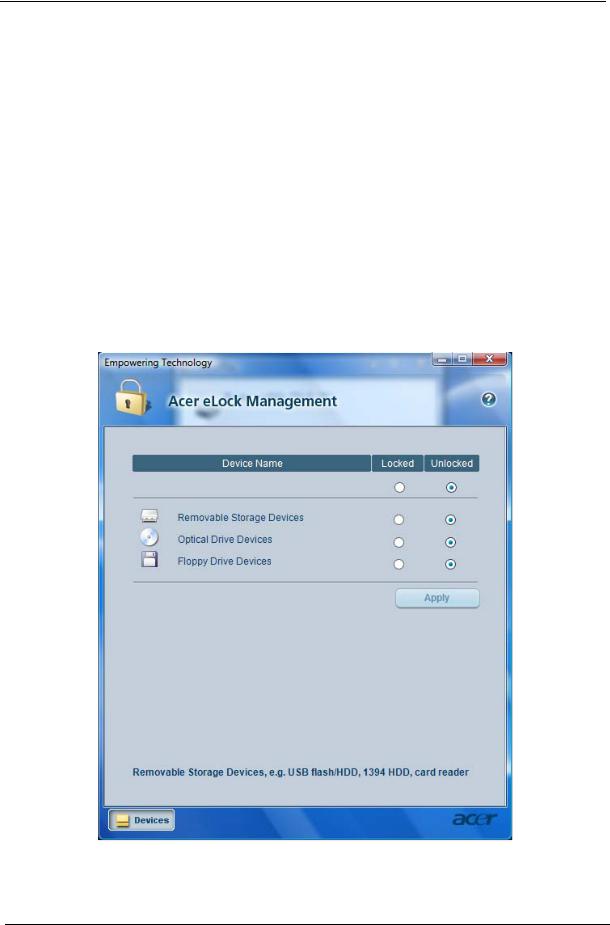
Acer eLock Management 
Acer eLock Management is a security utility that allows you to lock your removable data, optical and floppy drives to ensure that data cannot be stolen while your notebook is unattended.
Removable data devices - includes USB disk drives, USB pen drives, USB flash drives, USB MP3 drives, USB memory card readers, IEEE 1394 disk drives and any other removable disk drives that can be mounted as a file system when plugged into the system.
Optical drive devices - includes any kind of CD-ROM or DVD-ROM drives. Floppy disk drives - 3.5-inch disks only.
Interfaces - includes serial ports, parallel port, infrared (IR), and Bluetooth.
To activate Acer eLock Management, a password must be set first. Once set, you can apply locks to any of the devices. Lock(s) will immediately be set without any reboot necessary, and will remain locked after rebooting, until unlocked.
NOTE: If you lose your password, there is no method to reset it except by reformatting your notebook or taking your notebook to an Acer Customer Service Center. Be sure to remember or write down your password.
24 |
Chapter 1 |
